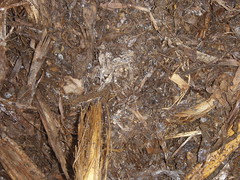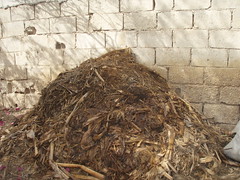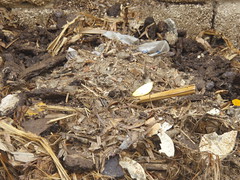We turned the compost for a second time on the afternoon of the 16th. We where a bit worried about what we might find, as it was so stinky on the first turn. We where happy to find that the compost was quite hot. It actually produced steam in 40 degree weather. It did not have much smell either. One part was a bit stinky, because it was too dry and not decomposing properly, we added a bit more water here. In fact the pile is composting a bit too quickly now. Notice the white residue in the middle of the picture. This indicates the presence of anaerobic bacteria, meaning the pile is using more oxygen than is present. If we do not address this problem the final product will be low quality. We are working to maximize the amount of aerobic life in the pile not anaerobic.
It is likely that the nitrogen ratio of the pile is a little bit high. As a first measure, the pile will be turned everyday. Hopeful turning the pile everyday will bring more oxygen into the system and fix the problem. If this does not work we may need to add a sparing amount of high carbon material such as shredded paper or cardboard. The addition of more material is a last resort. Adding more material after the composting process has started will increase the amount of time required to finish the pile off.
Will run-away climate change make drought permanent?
18 years ago







